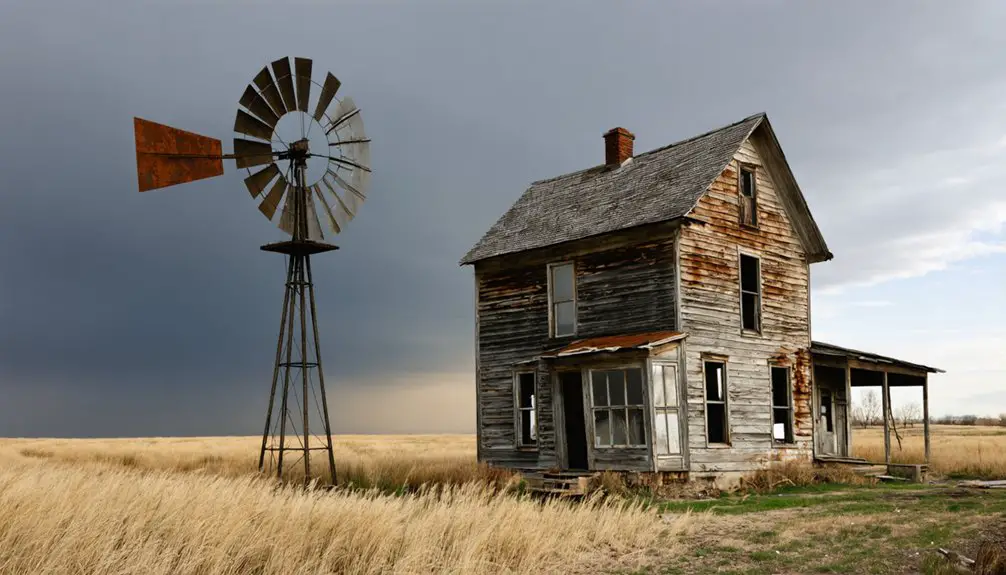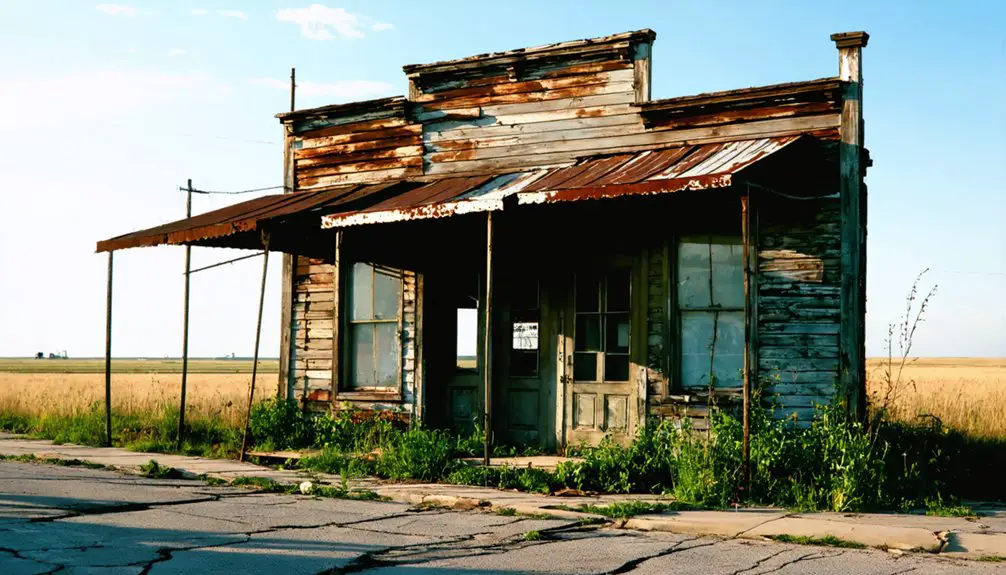You’ll find the ruins of Dobytown near Fort Kearny, Nebraska, where this adobe-built frontier outpost earned its reputation as one of the wildest settlements along the Oregon Trail. Established in 1859, it served as a crucial resupply point and Pony Express station, known for its lawless whiskey trade and dangerous characters. After the Union Pacific Railroad’s completion in 1869 and Fort Kearny’s abandonment in 1871, this once-bustling town became a symbol of the untamed American frontier.
Key Takeaways
- Dobytown, Nebraska was established in 1859 near Fort Kearny and gained prominence as a crucial frontier outpost before becoming a ghost town.
- Named for its adobe buildings, Dobytown served as a vital resupply point and Pony Express station along the Oregon Trail.
- The town was notorious for its lawlessness, featuring saloons, gambling houses, and brothels that catered to soldiers and travelers.
- Dobytown’s decline began with the completion of the Union Pacific Railroad in 1869 and Fort Kearny’s abandonment in 1871.
- Now listed on the National Register of Historic Places, Dobytown’s remains serve as a testament to America’s wild frontier era.
The Rise of a Frontier Outpost
When the Oregon Trail bustled with westward travelers in 1859, a small settlement called Kearney City emerged near Fort Kearny, quickly earning the nickname “Dobytown” for its earthen adobe-style buildings.
You’ll find that this frontier commerce hub strategically positioned itself as the first major outfitting point west of the Missouri River, serving the needs of soldiers, freighters, and pioneers that Fort Kearny couldn’t accommodate.
With 12-15 buildings showcasing simple adobe architecture, Dobytown‘s importance grew rapidly. You could witness its rise to prominence as it became Kearney County’s first county seat, establishing itself as a vital stopover for westbound travelers. A Pony Express station operated from the settlement, further cementing its role in frontier communications. Similar to Fort Kearny’s role as a supply depot, Dobytown provided essential provisions and services to emigrants traveling the trail.
The settlement’s strategic location made it an essential support center for the fort, while its independent spirit allowed it to thrive as a distinctive frontier community.
Life in Adobe Buildings Along the Oregon Trail
Along the Oregon Trail, adobe buildings offered emigrants a distinctive blend of practicality and regional adaptation.
You’d find these earthen structures serving as crucial waypoints where trails intersected civilization, providing shelter from extreme weather and a chance to resupply. Near Fort Kearny, these outposts became vital supply stops for weary travelers seeking provisions and rest. Traveling parties could find relief from the mile-wide corridor of dusty wagon trails.
Adobe architecture demanded constant attention, with settlers facing these key challenges:
- Maintaining walls against rain and wind erosion through regular replastering
- Managing limited interior space for multiple functions like trading, storage, and living
- Battling the elements through small windows and thick walls for temperature control
Inside these frontier havens, you’d discover sparse but functional spaces.
While adobe preservation proved challenging, these buildings represented freedom from the constraints of traditional construction materials, allowing pioneers to establish essential outposts using locally available resources.
Wild Tales From a Lawless Settlement
As Fort Kearny’s notorious neighbor, Dobytown earned its reputation as one of the most lawless settlements along the Oregon Trail, where tanglefoot whiskey flowed freely and violence erupted regularly.
You’d find gambling houses, brothels, and saloons catering to soldiers, traders, and pioneers seeking escape from the fort’s strict regulations. The settlement, established in 1859 near Kearny, became a magnet for those seeking entertainment away from military supervision.
The town’s lawless behavior drew opportunistic criminals who preyed on vulnerable travelers. You’d witness frontier justice firsthand as angry mobs nearly lynched suspected arsonists who’d torched valuable brick buildings.
During the height of Indian wars, the dangers intensified – wagon trains faced attacks while Dobytown’s own streets erupted in brawls between gamblers, thieves, and drunken visitors.
Despite Fort Kearny’s military presence nearby, the settlement remained a turbulent hub where vice and violence ruled supreme.
Strategic Importance During Western Expansion
You’ll find Dobytown’s strategic importance centered on its position as an essential military supply hub for Fort Kearny and its role as a Pony Express station during the peak of westward expansion.
As thousands of travelers pushed west along the Oregon Trail between 1860-1866, the settlement served as their last major resupply point beyond the Missouri River, offering necessary provisions and services. Originally established in 1859 as Kearney City, the town quickly became a vital waypoint for westward travelers.
Your journey through frontier history wouldn’t be complete without understanding how this commercial powerhouse supported soldiers, traders, and pioneers while facilitating critical communication and commerce across the American frontier.
Military Supply Hub Operations
During the height of America’s westward expansion, Dobytown emerged as an essential military supply hub three miles west of Fort Kearny, Nebraska. The town’s military logistics supported thousands of soldiers, including units like the First Nebraska Cavalry and Seventh Iowa Cavalry, while maintaining a critical supply chain for westbound travelers.
You’ll find these key operations defined Dobytown’s role:
- Served as the major outfitting point west of the Missouri River from 1860-1866
- Provided essential supplies including food, equipment, and the infamous “tanglefoot” whiskey
- Supported military escort operations by provisioning wagon trains that required armed protection
This strategic position made Dobytown indispensable until 1869, when the Union Pacific Railroad transformed military supply routes and ultimately led to Fort Kearny’s abandonment in 1871.
Pony Express Station Role
While Fort Kearny anchored military operations in Nebraska Territory, Dobytown’s Pony Express station emerged as an essential communications hub just two miles west of the fort.
As part of Division One’s network, you’d find this strategic relay point facilitating rapid mail delivery between Independence, Missouri, and the West Coast. Like the Smith Hotel in Troy, this station served multiple purposes beyond just mail delivery.
From 1860 to 1866, the station played a crucial role in connecting frontier settlements with the eastern United States. You could witness both military dispatches and civilian correspondence passing through, as riders maintained swift communication across the expanding western territories.
The station’s presence helped transform Dobytown into a bustling center of frontier transportation, serving travelers, soldiers, and settlers alike until the railroad’s arrival ultimately changed the dynamics of western communication.
Oregon Trail Commerce Center
Strategically positioned along major transportation routes, Dobytown emerged as an essential commerce hub serving Oregon Trail emigrants and traders in the mid-1800s. The town’s location near fresh water, wood supplies, and natural passes made it a crucial stop along established trade routes, ensuring economic sustainability for both travelers and merchants.
You’ll find Dobytown’s commercial significance reflected in these key aspects:
- Trading posts offering critical supplies, blacksmith services, and livestock for westward-bound settlers
- Transfer points for stage companies and freight operations moving cargo across the frontier
- Banking and financial services supporting settlers’ needs and trail outfitting
The town’s infrastructure, including locally quarried limestone buildings, demonstrated substantial investment in long-term commerce, while nearby transportation hubs influenced settlement patterns throughout the region. Like many frontier towns, its buildings served multiple purposes over time, from banking to fire halls, adapting to the community’s evolving needs. Similar to the historic Horse Creek Treaty Grounds, Dobytown served as a vital gathering place where diverse groups of people interacted and conducted business.
The Legacy of “Tanglefoot” and Trading Posts
You’ll find Dobytown’s most infamous claim to fame in “Tanglefoot” whiskey, a harsh spirit that General Sherman himself declared undrinkable yet perfectly captured the wild nature of this trading post.
While Fort Kearny maintained military discipline, Dobytown’s merchants created a booming business in everything from essential supplies to gambling and other vices that travelers sought.
The town’s strategic position as the major outfitting point west of the Missouri River from 1860 to 1866 made it an unavoidable stop for thousands of pioneers, soldiers, and traders who needed provisions for their westward journey.
Whiskey’s Wild Frontier Days
Throughout the wild frontier days of Dobytown, whiskey played a pivotal role in shaping the town’s character and conflicts. The whiskey culture fostered both commerce and chaos, as trading posts transformed into hubs for bootlegging operations during Prohibition. According to records from Dodge City’s early days, George Hoover charged two bits per ladle of whiskey from his pioneering saloon.
You’ll find that characters like “Queen” Louise Vinciquerra emerged as notorious figures, running illegal whiskey networks through Nebraska’s dusty streets.
The frontier’s whiskey-soaked reality included:
- High-speed chases and shootouts between bootleggers and law enforcement on rural highways
- Trading posts serving as essential economic links between settlers and Native American tribes
- Violent confrontations that created legendary figures who straddled the line between law and chaos
This potent spirit didn’t just fuel social gatherings – it sparked deadly disputes, challenged authority, and wove itself deeply into the fabric of frontier justice.
Trading Post Business Boom
When Dobytown emerged in 1859 near Fort Kearny, its trading posts quickly became the lifeblood of westward expansion.
You’d find these bustling commerce centers three miles from the fort, strategically positioned to offer goods and services the military wouldn’t allow within their boundaries.
The trading post dynamics transformed Dobytown into a frontier transportation hub during the early 1860s.
As commerce evolution took hold, these establishments didn’t just sell essential supplies – they became focal points for both legitimate trade and frontier vice.
You could purchase everything from food and tools to the infamous “tanglefoot” whiskey that General Sherman later condemned.
The trading posts’ success peaked between 1860 and 1866, boosted by Dobytown’s role as a Pony Express station and its reputation as the last major supply point west of the Missouri River.
Fort Kearny’s Supply Chain
As Fort Kearny emerged as an essential military outpost in 1848, its supply chain operations transformed the Great Plains into a complex network of freight logistics. The massive “Tanglefoot” wagon caravans, with their thousands of oxen and wagons, created a lifeline for westward expansion.
You’ll find the fort’s supply logistics were built on three vital elements:
- Massive freight operations by companies like Russell, Majors and Waddell
- Strategic storage of military supplies and trading goods
- A network of trading posts, including nearby Dobytown, that supplemented official provisions
The fort’s resourceful adaptations to challenges, like wood scarcity and communication delays, kept the supply chain flowing.
You’d see emigrants trading, selling, or abandoning wagons near the fort, creating a thriving secondary market that supported frontier development.
The Town’s Final Days and Modern Remains
The completion of the Union Pacific Railroad in 1869 marked the beginning of Dobytown’s swift decline, drastically reducing travel along the Oregon Trail and diminishing the town’s role as an essential stopover.
When the U.S. Army abandoned Fort Kearny in 1871, Dobytown’s fate was sealed. The once-bustling frontier town, with its dozen adobe buildings housing saloons and gambling halls, couldn’t survive without its steady stream of soldiers and pioneers.
Today, you’ll find this ghost town listed on the National Register of Historic Places, marked by a commemorative plaque at 800-814 State Highway 50A in Kearney, Nebraska.
While no original structures remain at the 2,129-foot elevation site, its historical significance lives on as a symbol of the wild frontier era and the boom-and-bust nature of America’s westward expansion.
Frequently Asked Questions
What Did Native American Tribes Think About Dobytown’s Presence?
You’ll find Native perspectives viewed the town as an unwelcome intrusion on their lands, while tribal relations deteriorated as they saw it representing expanding settlement that threatened their freedom and traditional way of life.
How Many People Typically Lived in Dobytown During Its Peak Years?
Like a frontier revolving door, you’d find about 100 permanent residents during the 1860s peak, though population dynamics shifted constantly as economic factors drew thousands of travelers through annually.
What Was the Average Cost of Goods and Services in Dobytown?
You’d find historical prices ran higher than established towns due to transportation costs, with limited cost comparisons available. Most goods and services were marked up considerably to serve travelers and soldiers.
Were There Any Notable Murders or Crimes That Occurred in Dobytown?
While records suggest violence and lawlessness, you won’t find specific documented murders in the town’s history. Local legends hint at unsolved mysteries, but details remain lost to the frontier’s unwritten past.
Did Any Famous Pioneers or Personalities Write About Their Experiences in Dobytown?
You’ll find General William T. Sherman’s description of “tanglefoot” whiskey is the most notable historical account, while other pioneer experiences are mainly preserved through brief mentions in travel logs and letters.
References
- https://kids.kiddle.co/Dobytown
- https://history.nebraska.gov/marker-monday-dobytown/
- https://www.onlyinyourstate.com/trip-ideas/nebraska/ne-ghost-towns-road-trip
- http://www.oocities.org/dustinmdudley/nebraska_dobytown_lowell_newark.html
- https://visitnebraska.com/trip-idea/explore-7-authentic-ghost-towns-nebraska
- https://en.wikipedia.org/wiki/Dobytown
- https://en.wikipedia.org/wiki/Fort_Kearny
- http://www.e-nebraskahistory.org/index.php?title=Nebraska_Historical_Marker:_Fort_Kearny
- https://history.nebraska.gov/wp-content/uploads/2017/12/doc_publications_NH1989Historic_Places.pdf
- https://npshistory.com/publications/jeff/newsletters/museum-gazette/oregon-trail-landmarks.pdf



